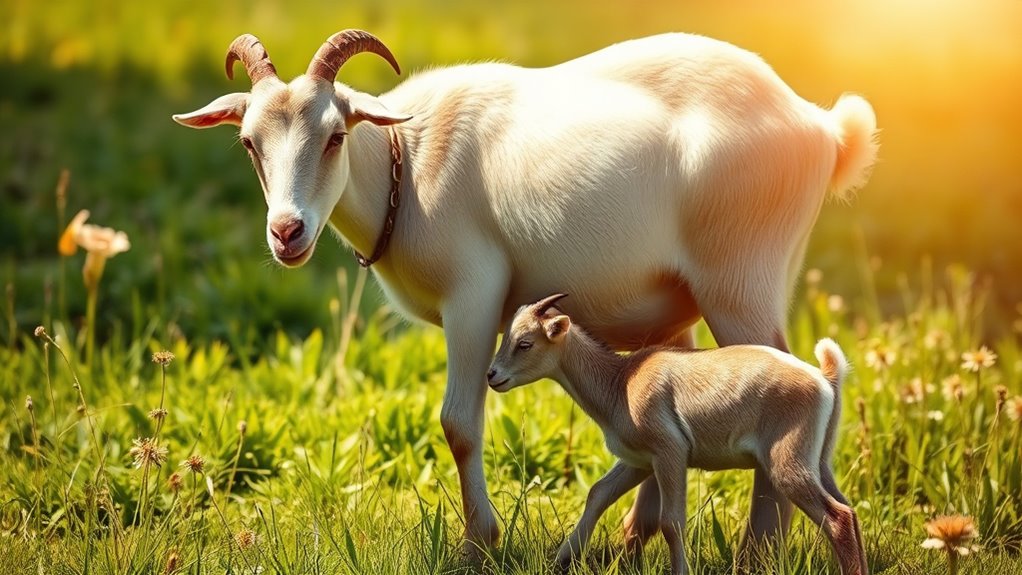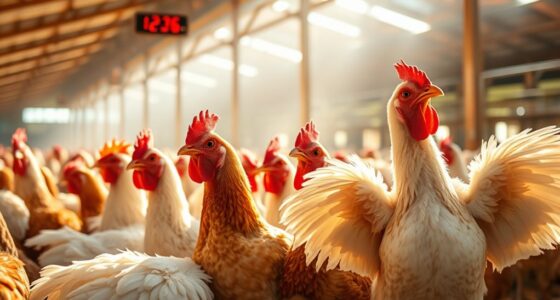When observing a pregnant goat, watch for changes in behavior, like increased affection or withdrawal. You might notice she's more restless or exhibits nesting behaviors as labor approaches. Physical signs include udder swelling and a bulging belly. She may also seek solitude and pace during contractions. Keep an eye on her appetite and vocalizations, as these can indicate her condition. There's much more to understand about her needs and care during this time.
Key Takeaways
- Pregnant goats may show changes in appetite, eating more but often experiencing a drop in milk production.
- Behavioral shifts include increased affection or withdrawal as they progress through pregnancy.
- As labor approaches, goats seek solitude and display nesting behaviors like pawing at the ground.
- Increased restlessness and vocalizations can indicate contractions during labor.
- Monitor for signs of discomfort or unusual behaviors like excessive yawning as they near kidding.
Signs of Pregnancy in Goats
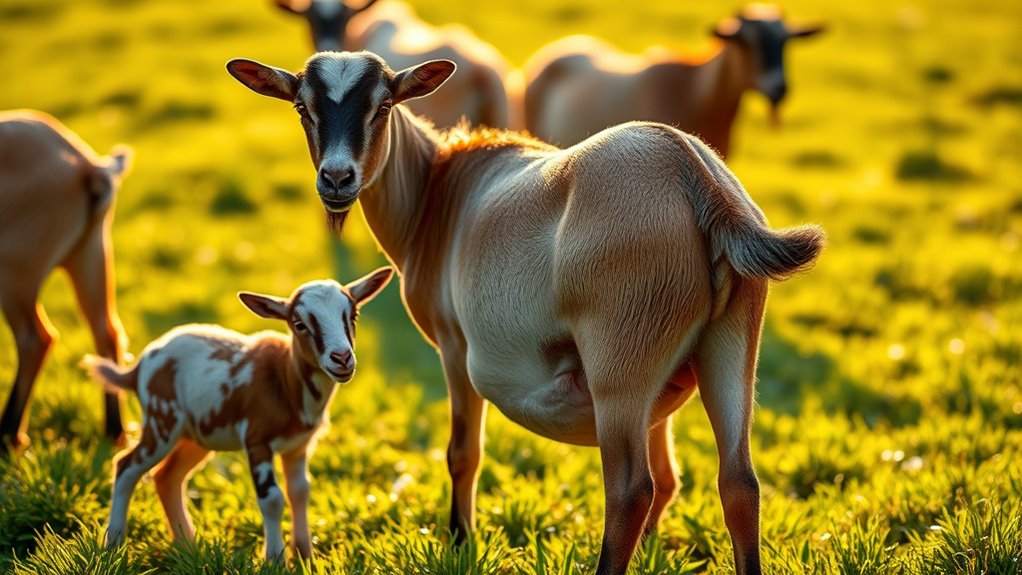
When it comes to recognizing signs of pregnancy in goats, there are several key indicators you should look for.
First, a pregnant goat won't return to heat, which typically occurs every 17-24 days.
You'll also notice changes in appetite; while they may eat more, milk production can drop if they're lactating.
Behavioral shifts are common—your goat might become more affectionate or, conversely, withdraw from interactions.
Also, as pregnancy progresses, you may observe increased restlessness or lethargy.
Keep an eye out for udder development, especially in seasoned does.
Lastly, if your goat starts gathering bedding materials, she might be preparing a nest for her kids.
These signs can help you confirm her pregnancy status.
Physical Changes During Pregnancy
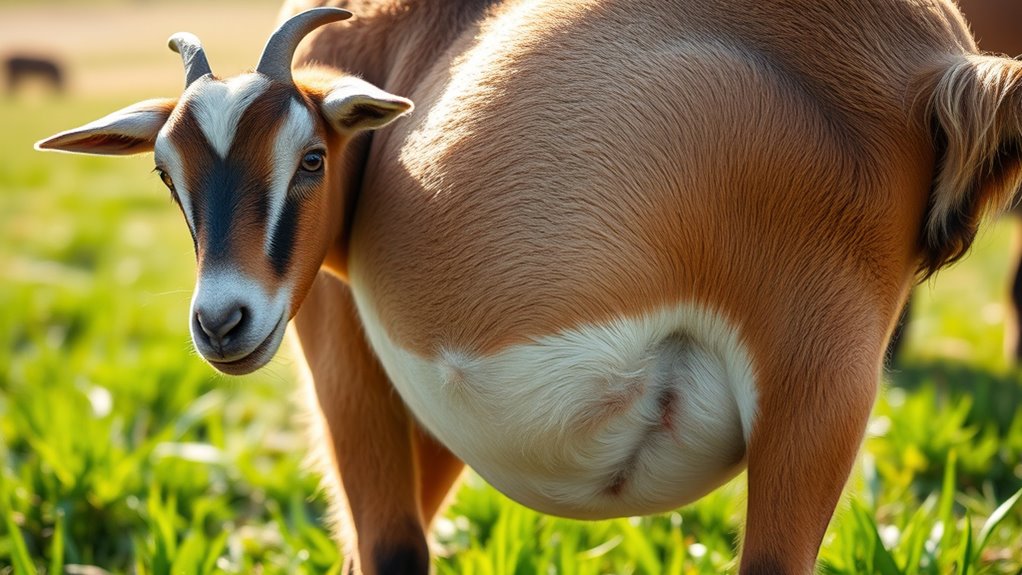
After identifying the signs of pregnancy in your goat, you'll start noticing various physical changes that indicate how far along she is.
Around six weeks after breeding, her udder will swell, especially in first-time does, with teats growing longer and thicker. As her belly expands, you might notice a right-side bulge due to fetal development.
Pregnant goats typically gain weight, so keep an eye on her body condition, as both underweight and overweight can pose risks. You may also feel fetal movement around three to four months in.
As she nears kidding, watch for softening ligaments, vulva swelling, and increased vocalizations. These changes are all signs that she's preparing for the arrival of her kids.
Behavioral Indicators of Labor
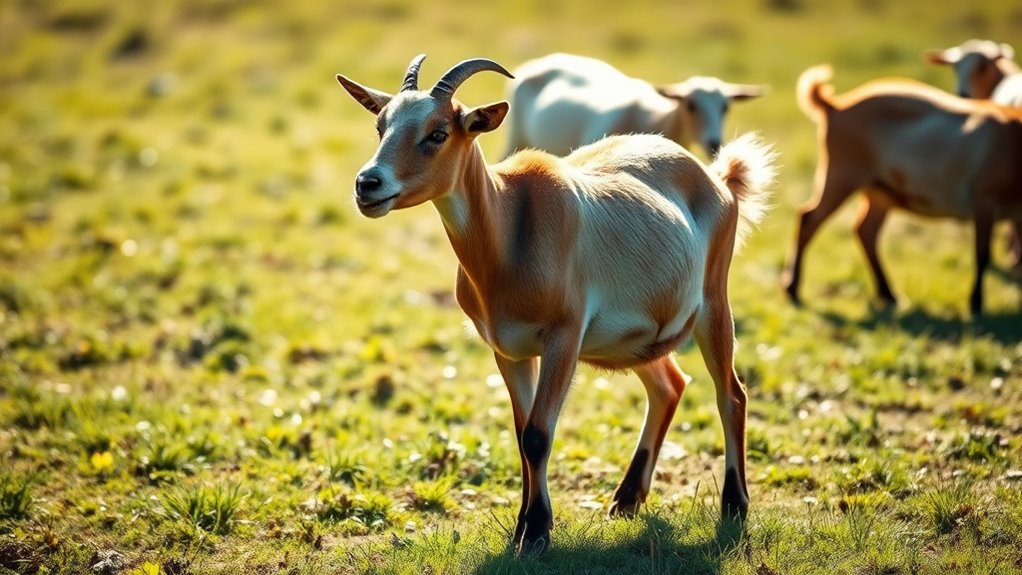
As your goat approaches labor, you'll likely notice distinct behavioral changes that signal the impending arrival of her kids. She may separate herself from the herd, seeking solitude within 24 hours of giving birth.
As labor approaches, your goat may seek solitude and exhibit distinct behavioral changes in preparation for her kids.
Nesting behavior becomes evident as she paws at the ground, arranging bedding for comfort. You'll also see restlessness—she'll pace and frequently stand and lie down, searching for the right position.
Increased vocalization is common, with her making sounds during contractions. Pay attention to her appetite, as it might decrease, and look for unusual behaviors like excessive yawning.
These signs indicate that your goat is preparing for labor, so be ready for the exciting event ahead!
Pre-Labor Personality Shifts

Because hormonal changes can significantly impact a pregnant goat's behavior, you might notice some shifts in her personality as she approaches labor.
Some does become more affectionate, seeking your attention, while others may withdraw and prefer solitude. You might also see her energy levels drop; she could be reluctant to climb or jump.
Increased vocalization is common, hinting at the impending labor. Additionally, restlessness may manifest, with her pacing or appearing disoriented.
Pay attention to any unusual friendliness in typically shy goats, as hormonal fluctuations can cause mood swings. Observing these behaviors closely will help you understand her needs and prepare for the upcoming changes in her life and yours.
Health Considerations for Pregnant Does
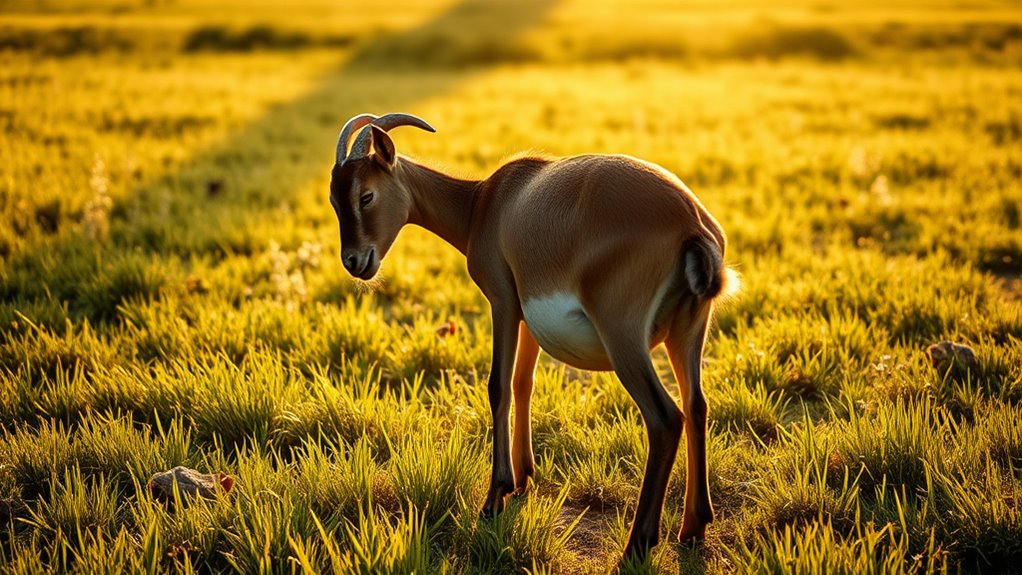
Monitoring the health of pregnant does is essential to ensure a smooth gestation and successful kidding. Start by assessing their body condition score (BCS) regularly, as being underweight can lead to complications.
Keep an eye out for nutrient deficiencies, which may cause metabolic disorders like pregnancy toxemia—balancing their diet is key. Ensure they've access to fresh, clean water to prevent dehydration and manage pasture to control parasites.
Regular veterinary checks can catch potential health issues early. As energy needs rise during late gestation, consider adjusting their diet with carbohydrates to support fetal growth and colostrum production.
Staying proactive about these health considerations will contribute significantly to the success of your pregnant does and their kids.
Nutritional Needs for Expecting Goats
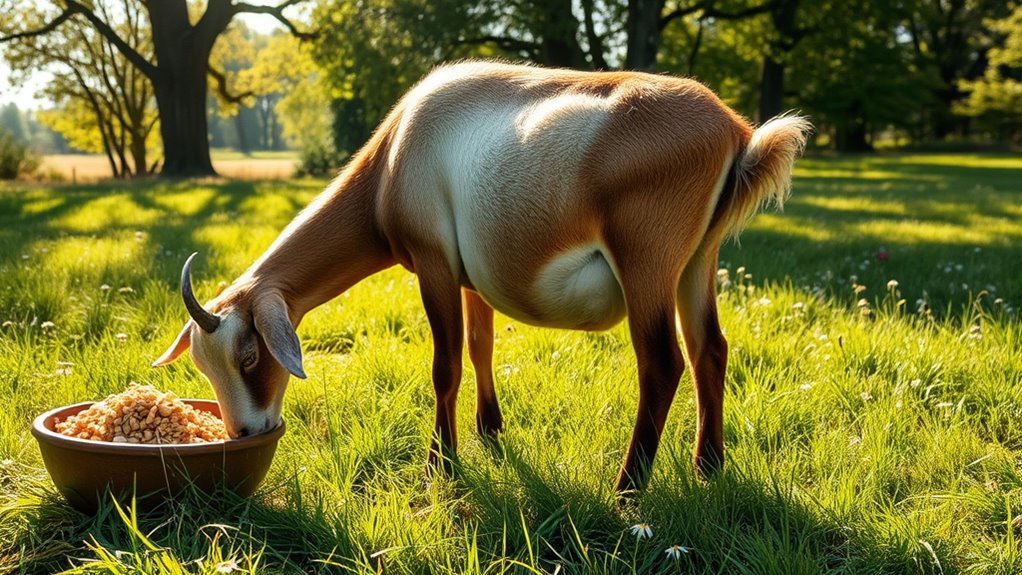
Understanding the nutritional needs of expecting goats is vital for their health and the development of their kids. During early pregnancy, focus on good hay or pasture to meet maintenance requirements.
As the pregnancy progresses, especially in late stages, you'll need to increase energy and protein intake significantly—up to 75% for twins. Incorporate high-quality hay, like alfalfa, to boost calcium levels and support fetal growth.
Don't forget about water; ensure your goats have access to clean water, as their intake may rise during pregnancy. Introduce grain gradually in late pregnancy to meet energy needs, while monitoring their body condition to avoid overfeeding.
Proper mineral supplementation is crucial for overall health and fetal development.
Monitoring for Complications
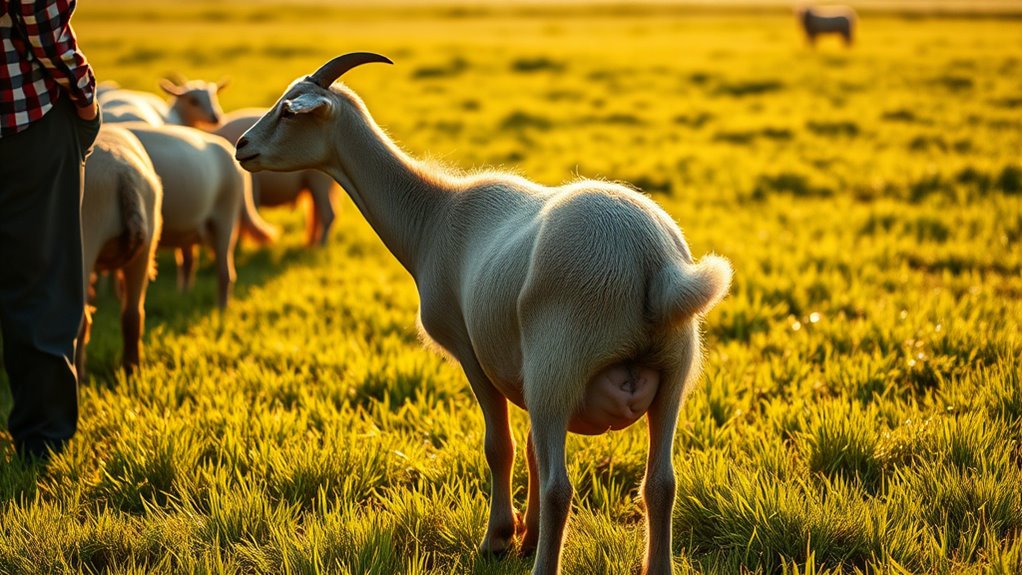
As you approach the final stages of your goat's pregnancy, keeping a close watch for potential complications becomes crucial.
Watch for signs of pregnancy toxemia, especially in the last six weeks, when energy demands rise and feed intake drops. Ketosis can occur in does with multiple fetuses, leading to decreased appetite and possible neurological symptoms.
Keep an eye out for pregnancy toxemia in the final weeks, as energy needs increase and appetite may decline.
Be alert for hypocalcemia, which manifests as a stiff gait or tremors, especially in older dairy goats. Vaginal prolapse may also happen, often requiring medical intervention.
Monitor for distress signs like refusal to eat, increased vocalization, and restlessness, as these could indicate complications. Quick assessment and veterinary assistance may be necessary to ensure your goat's health and safety.
Labor and Delivery Process
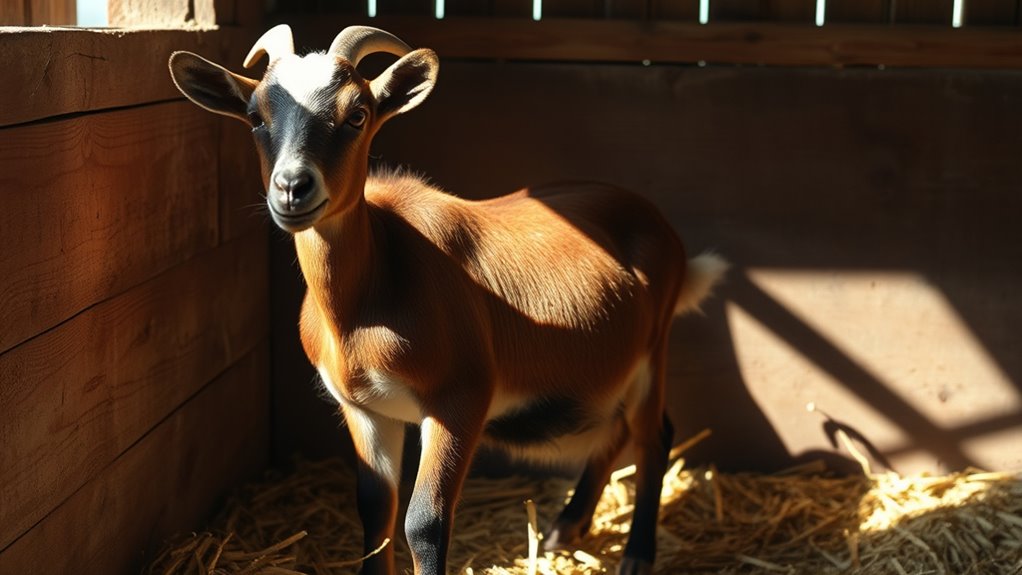
After keeping a watchful eye for complications during the final stages of your goat's pregnancy, it's time to prepare for the labor and delivery process.
The average gestation lasts about 150 days, and you'll notice signs like restlessness, back arching, and a thick discharge as labor nears.
During the first stage, which can last 4 to 12 hours, your doe may become increasingly restless and prefer solitude.
The second stage, typically under an hour for experienced mothers, begins with the appearance of the amniotic sac.
Keep an eye out for the kid's nose and front hooves.
If complications arise, like malpositioned kids, seek veterinary assistance promptly for a smooth delivery.
Post-Delivery Care for Doe and Kid
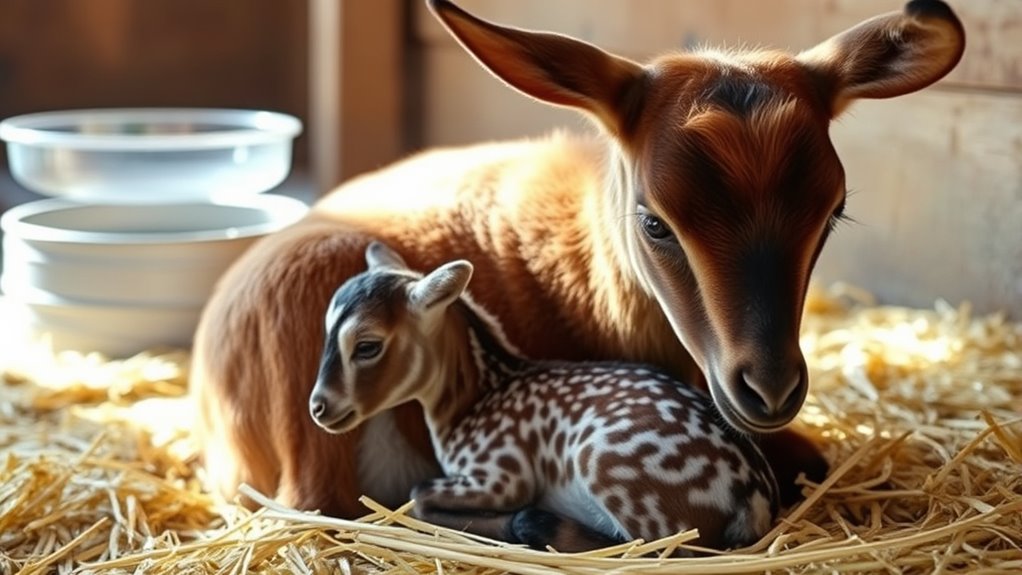
Post-delivery care is crucial for both the doe and her kids to ensure their health and well-being. Start by providing the doe with warm water mixed with molasses or electrolytes to keep her hydrated and energized.
Monitor her udder for mastitis and strip each teat to prevent blockage. Gradually introduce concentrate to support her nutrition.
For the kids, make sure they breathe properly and ingest colostrum within the first few hours. Trim their umbilical cords and dip them in iodine to avoid infection.
Keep a close eye on their vigor and responsiveness. Create a warm, clean environment for bonding, and don't hesitate to seek veterinary support if any health issues arise.
Record essential details for future reference.
Frequently Asked Questions
How Long Is the Average Goat Pregnancy?
The average goat pregnancy lasts about 150 days, which is roughly five months.
Depending on the breed, it can vary slightly; miniature goats usually have shorter pregnancies, around 145-150 days, while standard breeds may go up to 155 days.
Factors like the doe's health, nutrition, and environmental conditions can also influence this duration.
Can Goats Experience False Pregnancies?
Absolutely, goats can experience false pregnancies, and it can feel like the world's most confusing riddle!
Known as pseudopregnancy, this condition occurs when a goat shows signs of being pregnant without actually carrying a fetus.
You'll notice symptoms like abdominal swelling and udder enlargement.
It's essential to diagnose this accurately, as it can impact breeding plans.
If you suspect it, consulting a vet will help clarify the situation and guide you on treatment.
What Breeds Are More Prone to Pregnancy Complications?
If you're considering goat breeds, be aware that Boer goats and high-producing dairy breeds are more prone to pregnancy complications.
Over-conditioned does, regardless of breed, can also face increased risks. Additionally, does carrying multiple fetuses have higher energy demands, raising the chance of pregnancy toxemia.
To mitigate these risks, focus on proper nutrition and monitoring body condition, ensuring your goats remain healthy throughout their pregnancy.
How Can I Tell if a Doe Is in Distress?
Imagine you're watching a doe pacing back and forth, her eyes wide with stress. You can tell she's in distress if she's restless, frequently lying down and getting back up.
Listen for increased vocalizations like bleating or moaning; they're signs of discomfort. If she shows abnormal posture or straining without progress during labor, it's crucial to act quickly.
Keep an eye out for changes in appetite and social behavior, too.
What Should I Do if My Doe Refuses to Eat?
If your doe refuses to eat, first assess her environment for stressors like weather changes or transportation.
Check her body condition and look for any signs of illness or injury, as these can affect appetite.
Offer her high-quality, palatable feed, and consider supplements if needed.
It's crucial to monitor her closely and consult a veterinarian if her refusal continues, especially if you notice other concerning symptoms like lethargy or behavioral changes.
Conclusion
In conclusion, keeping an eye on your pregnant goat's behavior is essential for their health and the well-being of their kids. Interestingly, studies show that about 95% of goats give birth without complications when provided with proper care. By recognizing the signs of pregnancy, understanding their needs, and being attentive during labor, you can ensure a smooth delivery and a healthy start for both the doe and her kids. Your vigilance makes all the difference!

